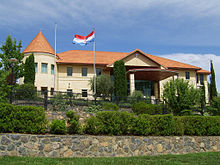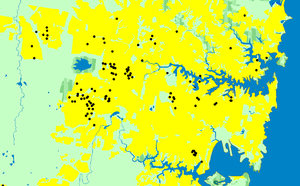- Croatian Australian
-
Croatian Australian 





Notable Croatian Australians:
Eric Bana · Natasha Stott Despoja
Laura Dundovic · Simon Katich
Matthew Pavlich · Mark VidukaTotal population 90,995 (Croatian-born in 2006)[1]
128,046 (Croatian ancestry in 2006)[2]Regions with significant populations Melbourne, Sydney, Wollongong, Perth, Geelong Languages Religion predominantly Roman Catholic
Part of a series of articles on Croats  RecognizedSubgroups
RecognizedSubgroupsCroatia has been a source of migrants to Australia, particularly in the 1960s and 1970s. In 2006, 128,051 persons resident in Australia (0.6%) identified themselves as having Croatian ancestry.
Contents
History
Croats were first noticeable in Australia during the gold rushes of the 1850s in the province of Victoria. At this time, Croats were coded as "Austrians" because most of Croatia was a part of the Habsburg Empire. By Australian federation in 1901, there were many Croats - mainly from Dalmatia — in Australia, counted with Czechs, Hungarians, Serbs, Slovaks and others as "Austro-Hungarians". The establishment of the Kingdom of Serbs, Croats and Slovenes from Austria-Hungary after the First World War — and its replacement Yugoslavia in 1945 — continued to make it difficult to separate out Croats from other ethnicities in Australia. Croats were not recorded separately until the 1996 Census. The Australian Department of Immigration believes many Croats holding old (and now long out of date) Yugoslav passports still record themselves as Yugoslavs in Australian censuses, over a decade after the disintegration of Yugoslavia.
Nevertheless, it is known that Croats formed a large proportion of those Yugoslavs who settled in Australia the 1960s and 1970s under Australian Government migration schemes.[citation needed] The Yugoslavia-born population reached 129,616 by the 1971 Census and 160,479 by the 1991 Census. The greatest number settled in Sydney and Melbourne, though Croats are well represented in every Australian city and region.
During the 1960s and 1970s, many Croatians were constantly under ASIO surveillance for alleged terrorist activities organised by the Yugoslave secret service, several of whom were named in the media. Some of the longest running and most expensive court cases in Australian history involved Croatians charged with terrorist related charges that were proven falsified, including the 'Croatian Six' who were convicted on tainted evidence. Federal Attorney-General Lionel Murphy created a media sensation when he led a raid on ASIO Headquarters looking for files on Croatian terrorist activities and not finding any at all, spurred on by claims of nonsurveillance by ASIO and that ASIO focused too much of its time on student anti-war groups instead of terrorist groups, though there may have been no terrorist activities for ASIO to investigate.[3]
Croatian Embassy in Canberra
In November 1977, an unofficial Croatian embassy was opened in Canberra, causing a legal and diplomatic difficulty for both the Australian and Yugoslav governments.[4] The embassy, aimed at raising awareness of Croatia as a nation and the Croatian people separate from Yugoslavia, remained open for a period of 23 months before closing in 1979. Its ambassador Mario Dešpoja is the father of former Democrats Leader Natasha Stott Despoja.
Since the independence of Croatia in the 1990s, an official embassy has been opened in Canberra and consulates have been opened in Melbourne, Sydney and Perth.
Demographics
At the 2006 Census 50,993 persons resident in Australia identified themselves as having been born in Croatia, representing about 0.25% of the Australian population.[1] The Census also noted 118,046 persons identified themselves as having Croatian ancestry, either alone or in combination with another ancestry.[2]
Croatian Australians are more likely to be resident in Victoria than any other state. As at 2006, 35.7% of Croats live in Victoria (where only 25% of the total Australian population reside[5]). A further 36.2% of Croatian Australians reside in New South Wales (compared with 33% of the total Australian population[5]).[6]
As the level of immigration from Croatia has dropped significantly from the 1980s (70% of Australian residents born in Croatia arrived before 1980[6] ), the Croatian-born population is ageing: 43% of the Croatian-born population was aged sixty years old or older at the time of the 2006 Census.[6]
As at the 2006 census 33,012 Croatian-born Australians (65%) speak Croatian at home; 17% of Croatian-born Australians speak English at home.[6] Proficiency in English was self-described by census respondents as very well by 31%, well by 32%, 17% not well, 2.3% not at all (18% didn't state or said not applicable).[6] In 2001, the Croatian language was spoken at home by 69,900 persons in Australia.[citation needed] Croatian is the tenth most widely spoken language in the country after English, the Chinese languages, Italian, Greek, Arabic, Vietnamese, Spanish, Tagalog, German, and Macedonian.[citation needed]
Of the Australian residents who were born in Croatia , 48,271 or 95% were Australian citizens at the time of the 2006 census.[6]
According to 2006 census data released by the Australian Bureau of Statistics, 94% of Croatian born Australians recorded their religion as Christian.[6] 2001 census data released by the Australian Bureau of Statistics in 2004, showed denominational affiliation by Croatian Australians was: 85.6% Catholic, 0.9% Anglican, 4.5% Other Christian, 1.4% claiming other Religions, and 7.6% claiming no religious affiliation.[citation needed]
Croatian Australians have an exceptionally low rate of return migration to Croatia. In December 2001, the Department of Foreign Affairs estimated that there were 1,000 Australian citizens resident in Croatia, mainly in Zagreb.[7]
Croatian Australians and Soccer
Croats in Australia and their Croatian Australian offspring are notable for their commitment to association football, with numerous clubs established throughout the country, the most notable and successful being Sydney Croatia and Melbourne Croatia. These clubs nurtured the footballing talents of a large number of Croatian Australians, many of whom now play professionally overseas. Croatian Australians have played for both Croatia and Australia. In the 2006 World Cup, there were seven Croatian Australians playing for Australia and three playing for Croatia. There have been 45 Croatian Australians that have gone on to play for the Australian national football team, including 6 that captained the national team. The Australian - Croatian Soccer Tournament is the oldest non defunct soccer competition in Australia
Croatian Australian Socceroos
- Zeljko Adzic
- Zlatko Arambasic
- Mark Babic
- Zeljko Babic
- Yaka Banovic
- Paul Bilokapic
- Mark Bosnich
- Oliver Bozanic
- Vic Bozanic
- Marco Bresciano
- Branko Buljevic
- Ante Covic
- Jason Culina (C)
- Eugene Galekovic
- Steve Horvat (C)
- Mile Jedinak
- Ante Juric
- Frank Juric
- Zeljko Kalac (C)
- Steve Kokoska
- Eddie Krncevic (C)
- Tony Krslovic
- Andrew Marth
- Frank Micic
- Ljubo Milicevic
- Ante Milicic
- Branko Milosevic
- Ante Moric
- Jason Petkovic
- Michael Petkovic
- Tom Pondeljak
- Tony Popovic
- Ivo Prskalo
- Ivo Rudic
- Wally Savor
- Josip Skoko (C)
- Matthew Spiranovic
- Mark Talajic
- Dario Vidosic
- Mark Viduka (C)
- Billy Vojtek
- Robert Zabica
- Ruben Zadkovich
- David Zdrilic
- Ned Zelic
List of Croatian Australians
- Eric Bana - actor
- Adrian Barich - Australian rules and Rugby League footballer
- Mark Bosnich - football (soccer) player, Australia
- Jim Bosnjak - Former owner of Westbus, the biggest bus company in Australia
- Mark Bresciano - football (soccer) player, Palermo and Australia (Croatian mother)
- Andrew Bogut - basketball player, Milwaukee Bucks
- Ivan Cleary Rugby league coach, former player
- Ante Čović- football (soccer) player, Elfsborg and Australia
- Jason Čulina- football (soccer) player, Gold Coast United and Australia
- Ante Dabro - sculptor
- Alan Didak - Australian rules footballer
- John Dorotich - Australian rules footballer
- Charmaine Dragun - journalist
- Laura Dundovic - Top 10 finalist of Miss Universe 2008
- Mate Dugandzic - football (soccer) player, Melbourne Victory
- Ray Gabelich - Australian rules footballer
- Darren Gaspar - Australian rules footballer
- Brent Grgić - Australian rules footballer
- Ivan Henjak - Rugby league coach, former player
- Matt Henjak - Rugby union player, Toulon and formerly Australia (nephew of Ivan)
- Allen Jakovich - Australian rules footballer
- Glen Jakovich - Australian rules footballer
- Željko Kalac- football (soccer) player, Kavala and Australia
- Simon Katich - Australian Cricket representative
- Blaž Kraljević - Croatian and Bosnian general
- Tony Krsticevic - politician, WA
- Robert Luketić - director
- Tatjana Lukić - poetry editor and poet
- Dean Lukin - Olympic weight lifting gold medalist
- Ivan Maric - Australian rules footballer
- Len Pascoe - Australian Cricket representative
- Mathew Pavlich - Australian rules footballer
- Val Perovic - Australian rules footballer
- Tony Popović- football (soccer) player
- Jaye Radisich - politician, WA
- Ljiljanna Ravlich - politician, WA
- Steven Salopek- Australian rules footballer
- Tony Santic - Millionaire tuna fisherman, horsebreeder and owner of Makybe Diva
- Ralph Sarich - Inventor of the revolutionary Orbital Engine.
- Josip Skoko-football (soccer) player, Hajduk Split and Australia
- Josip Šimunić - football (soccer) player, Hoffenheim and Croatia
- Marisa Siketa- actress.
- Anthony Šerić- football (soccer) player, Hajduk Split and Croatia
- Craig Starcevich - Australian rules footballer
- Natasha Stott Despoja - federal politician
- Peter Sumich - Australian rules footballer
- Erik Surjan - Decathlete
- Jacob Surjan - Australian rules footballer
- Bernard Tomić - Tennis Player
- Mark Viduka - football (soccer) player, Australia; currently a free agent, most recently with Newcastle United
- David Zdrilić- football (soccer) player
- Ned Zelić - former football (soccer) player for numerous club teams and Australia, now soccer TV analyst
See also
- Croats of Chile
References
- ^ a b "20680-Country of Birth of Person (full classification list) by Sex - Australia" (Microsoft Excel download). 2006 Census. Australian Bureau of Statistics. http://www.censusdata.abs.gov.au/ABSNavigation/prenav/ViewData?action=404&documentproductno=0&documenttype=Details&order=1&tabname=Details&areacode=0&issue=2006&producttype=Census%20Tables&javascript=true&textversion=false&navmapdisplayed=true&breadcrumb=POLTD&&collection=Census&period=2006&productlabel=Country%20of%20Birth%20of%20Person%20(full%20classification%20list)%20by%20Sex&producttype=Census%20Tables&method=Place%20of%20Usual%20Residence&topic=Birthplace&. Retrieved 2008-06-02. Total count of persons: 19,855,288.
- ^ a b "20680-Ancestry (full classification list) by Sex - Australia" (Microsoft Excel download). 2006 Census. Australian Bureau of Statistics. http://www.censusdata.abs.gov.au/ABSNavigation/prenav/ViewData?breadcrumb=POLTD&method=Place%20of%20Usual%20Residence&subaction=-1&issue=2006&producttype=Census%20Tables&documentproductno=0&textversion=false&documenttype=Details&collection=Census&javascript=true&topic=Ancestry&action=404&productlabel=Ancestry%20(full%20classification%20list)%20by%20Sex&order=1&period=2006&tabname=Details&areacode=0&navmapdisplayed=true&. Retrieved 2008-06-02. Total responses: 25,451,383 for total count of persons: 19,855,288.
- ^ David McKnight. Australia's Spies and Their Secrets. Allen & Unwin. St Leonards, N.S.W. 1994.
- ^ Croatian Embassy in Canberra - 1977-1978
- ^ a b "3101.0 - Australian Demographic Statistics, Dec 2006 (rebased on 2006 Census results)". Australian Bureau of Statistics. 2007-06-19. http://www.abs.gov.au/AUSSTATS/abs@.nsf/Previousproducts/3101.0Feature%20Article1Dec%202006?opendocument&tabname=Summary&prodno=3101.0&issue=Dec%202006&num=&view=. Retrieved 2008-07-21. Estimated resident population, preliminary - 30 June 2006 in '000s were NSW 6 817.2 Vic 5 128.3 Qld 4 091.5 SA 1 568.2 WA 2 059.0 Tas 489.9 NT 210.7 ACT 334.2 Australia 20 701.5
- ^ a b c d e f g "2914.0.55.002 2006 Census Ethnic Media Package" (Excel download). Census Dictionary, 2006 (cat.no 2901.0). Australian Bureau of Statistics. 2007-06-27. http://www.abs.gov.au/ausstats/subscriber.nsf/0/5618AB4511347DC2CA257306000D44C2/$File/2914055002_2006%20(Reissue).xls. Retrieved 2008-07-14.
- ^ "Estimates of Australian Citizens Living Overseas as at December 2001" (PDF). Southern Cross Group (DFAT data). 2001-02-14. http://www.southern-cross-group.org/archives/Statistics/Numbers_of_Australians_Overseas_in_2001_by_Region_Feb_2002.pdf. Retrieved 2008-07-15.
External links
- http://www.cronet.com.au/ - Australian Croatian community portal
Further reading
- Colic-Peisker, Val.(2000) Croatian and Bosnian migration to Australia in the 1990s. Studies in Western Australian history, No.21, (Being Australian women), p. 117-136.
- Colic-Peisker, Val.(2004) Split lives : Croatian Australian stories North Fremantle, W. Aust. : Fremantle Arts Centre Press. ISBN 1920731083
Ethnic groups in Australia Australia 
Europe NorthernWesternCentralSouthernBalkanAlbanian · Bosnian · Bulgarian · Croatian · Kosovan · Macedonian · Montenegrin · Romanian · Serbian · SloveneEasternRussian · UkrainianAsia EastSouthSoutheastWestAmericas NorthAmerican · CanadianCaribbeanJamaican · Trinidadian and TobagonianAfrica Oceania Fijian · Maori · New Zealander · Samoan
Croatian diaspora Europe Americas Oceania Australia · New ZealandEuropean Australians Central Europe Eastern Europe Albanian · Belarusian · Bosnian · Bulgarian · Croatian · Georgian · Estonian · Finnish · Jewish1 · Latvian · Lithuanian · Macedonian · Montenegrin · Romanian · Russian2 · Rusyn · Serbian · Slovene · Ukrainian
Northern Europe Southern Europe Basque · Catalan · Greek · Italian (Sicilian) · Maltese · Portuguese · Spanish
Western Europe Categories:- Australian people of Croatian descent
- Croatian diaspora
- Ethnic groups in Australia
- Immigration to Australia
Wikimedia Foundation. 2010.




